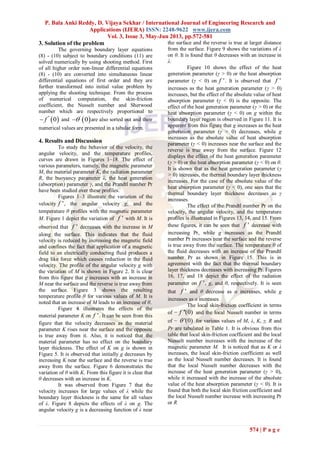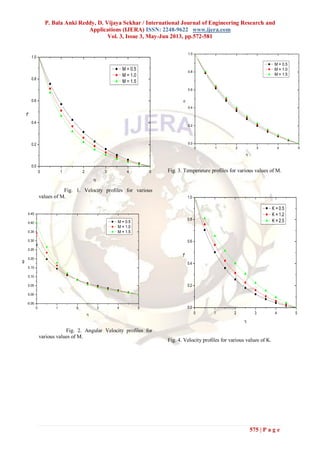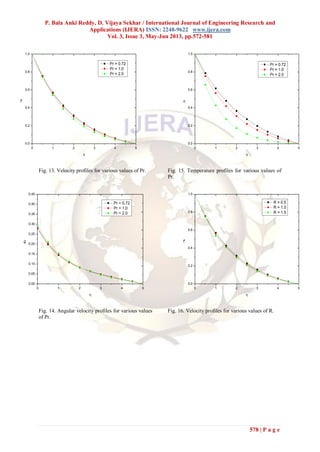The document presents a theoretical analysis of the magnetohydrodynamic mixed convection flow of a micropolar fluid over a heated stretching surface, with a focus on radiation and heat generation/absorption effects. The numerical solutions, obtained using the shooting method, indicate that various parameters, such as the magnetic parameter and heat generation parameter, significantly affect the fluid's velocity, temperature profiles, and relevant coefficients. Results show that increasing the magnetic field reduces fluid velocity, while heat generation enhances it, with corresponding impacts on skin friction and Nusselt numbers.
![P. Bala Anki Reddy, D. Vijaya Sekhar / International Journal of Engineering Research and
Applications (IJERA) ISSN: 2248-9622 www.ijera.com
Vol. 3, Issue 3, May-Jun 2013, pp.572-581
572 | P a g e
Effects Of Radiation On Mhd Mixed Convection Flow Of A
Micropolar Fluid Over A Heated Stretching Surface With Heat
Generation/Absorption
P. Bala Anki Reddy*and D. Vijaya Sekhar**
*Department of Mathematics, Fluid dynamics division, VIT University, Vellore-632014, Tamil Nadu.
**Department of Mathematics, NBKRIST, Vidyanagar, Nellore, A.P., India.
Abstract
A theoretical analysis is performed to
study the flow and heat transfer characteristics
of magnetohydrodynamic mixed convection flow
of a micropolar fluid past a stretching surface
with radiation and heat generation/absorption.
The transformed equations solved numerically
using the shooting method. The effects of the
velocity, the angular velocity, and the
temperature for various values of different
parameters are illustrated graphically. Also, the
effects of various parameters on the local skin-
friction coefficient and the local Nusselt number
are given in tabular form and discussed. The
results show that the mixed convection
parameter has the effect of enhancing both the
velocity and the local Nusselt number and
suppressing both the local skin-friction
coefficient and the temperature. It is found that
local skin-friction coefficient increases while the
local Nusselt number decreases as the magnetic
parameter increases. The results show also that
increasing the heat generation parameter leads to
a rise in both the velocity and the temperature
and a fall in the local skin-friction coefficient and
the local Nusselt number. Furthermore, it is
shown that the local skin-friction coefficient and
the local Nusselt number decrease when the slip
parameter increases.
Keywords: Radiation, stretching surface,
micropolar fluid, heat transfer, heat source.
1.Introduction
The fluid dynamics due to a stretching
surface and by thermal buoyancy is of considerable
interest in several applications such as aerodynamic
extrusion of plastic sheets, the boundary layer along
a liquid film in condensation processes, paper
production, glass blowing, metal spinning and
drawing plastic films. Free and mixed convections
of a micropolar fluid over a moving surface have
been studied by many authors [1–9] under different
situations. Desseaux and Kelson [10] studied the
flow of a micropolar fluid bounded by a linearly
stretching sheet while Bhargava et. al. [11] studied
the same flow of a micropolar flow over a non-
linear stretching sheet. The theory of micropolar
fluid was first introduced and formulated by Eringen
[12]. Later
Eringen [13] generalized the theory to incorporate
thermal effects in the so-called thermo micropolar
fluid. Crane [14] first obtained an elegant analytical
solution to the boundary layer equations for the
problem of steady two dimensional flow due to a
stretching surface in a quiescent incompressible
fluid. Gupta and Gupta [15] extended the problem
posed by Crane [14] to a permeable sheet and
obtained closed-form solution, while Grubka and
Bobba [16] studied the thermal field and presented
the solutions in terms of Kummer’s functions. The
3-dimensional case has been considered by Wang
[17]. Chen [18] studied the case when buoyancy
force is taken into consideration, and Magyari and
Keller [19] considered exponentially stretching
surface. The heat transfer over a stretching surface
with variable surface heat flux has been considered
by Char and Chen [20], Lin and Cheng [21],
Elbashbeshy [22] and very recently by Ishak et al.
[23], Mostaffa Mahmoud and Shimaa Waheed [24].
All of the above mentioned studies dealt with
stretching sheet where the flows were assumed to be
steady.
The aim of this work is to investigate the
effect of radiation on the flow and heat transfer of a
micropolar fluid over a vertical stretching surface in
the presence of heat generation (absorption) and
magnetic field, where numerical solutions are
obtained using shooting method.
2. Formulation of the Problem
Consider a steady, two-dimensional
hydromagnetic laminar convective flow of an
incompressible, viscous, micropolar fluid with a
heat generation (absorption) on a stretching vertical
surface with a velocity ( )wv x . The flow is assumed
to be in the x-direction, which is taken along the
vertical surface in upward direction and y-axis
normal to it. A uniform magnetic field of strength B0
is imposed along y-axis. The magnetic Reynolds
number of the flow is taken to be small enough so
that the induced magnetic field is assumed to be
negligible. The gravitational acceleration g acts in
the downward direction.](https://image.slidesharecdn.com/ct33572581-130523023448-phpapp02/85/Ct33572581-1-320.jpg)
![P. Bala Anki Reddy, D. Vijaya Sekhar / International Journal of Engineering Research and
Applications (IJERA) ISSN: 2248-9622 www.ijera.com
Vol. 3, Issue 3, May-Jun 2013, pp.572-581
573 | P a g e
The temperature of the micropolar fluid far away
from the plate is T∞, whereas the surface
temperature of the plate is maintained at Tw, where
( )wT x T ax , a > 0 is constant, and Tw > T∞.
The temperature difference between the body
surface and the surrounding micropolar fluid
generates a buoyancy force, which results in an
upward convective flow. Under usual boundary
layer and Boussinesq approximations, the flow and
heat transfer in the presence of heat generation
(absorption) are governed by the following
equations:
0
u v
x y
(1)
22
0
2
Bu u k u k N
u v g T T u
x y y y
(2)
2
0
2
2
N N N k u
u v N
x y j y j y
(3)
2
0
2
1 r
p p p
QqT T k T
u v T T
x y c y c y c
(4)
Subject to the boundary conditions:
( )wu u x cx , 00,
u
v N m
y
, ( ) 0wT T x at y
0, 0,u N T T as y (5)
where u and v are the velocity components in the x
and y directions respectively, T is the fluid
temperature, N is the component of the
microrotation vector normal to the x-y plane, ρis the
density, j is the microinertia density, μ is the
dynamic viscosity, k is the gyro-viscosity (or vortex
viscosity), β is the thermal expansion coefficient, σ
is the electrical conductivity, pc is the specific heat
at constant pressure, κ is the thermal conductivity, c
is a positive constant of proportionality, x measures
the distance from the leading edge along the surface
of the plate, and 0 is the spin-gradient viscosity.
Thermal radiation is simulated using the Rosseland
diffusion approximation and in accordance with this,
the radiative heat flux rq is given by:
* 4
*
1
4
3
r
T
q
k y
Where
*
is the Stefan–Boltzman constant and
*
1k
is the Rosseland mean absorption coefficient.
We follow the recent work of the authors [25, 26] by
assuming that 0 is given by
0 1
2 2
k K
j j
(6)
This equation gives a relation between the
coefficient of viscosity and micro inertia, where K =
k/μ (> 0) is the material parameter, j = ν/c, j is
the reference length, and m0 (0 ≤ m0 ≤ 1) is the
boundary parameter. When the boundary parameter
m0 = 0, we obtain N = 0 which is the no-spin
condition, that is, the microelements in a
concentrated particle flow close to the wall are not
able to rotate (as stipulated by Jena and Mathur
(27)). The case m0 = 1/2 represents the weak
concentration of microelements. The case
corresponding to m0 = 1 is used for the modelling of
turbulent boundary layer flow (see Peddieson
andMcnitt (28)).
We introduce the following dimensionless
variables:
1 1 22 2 1
02
, , ', , , ,
w
BT Tc c
y N cx g u cxf v c f M
T T c
* *
01 1 1
2 * 3 * 3
3 3
, ,Pr , , ,
16 16
p
p
c Qk k k kg a k
R K R
c T k cc T
(7)
Through (7), the continuity (1) is automatically
satisfied and (2) – (4) will give then
2
''' '' ' '
1 ' 0K f ff f Kg Mf
(8)
'' ' '
1 2 '' 0
2
K
g fg f g K g f
(9)
'' ' '1 1
1 0
Pr
f f
R
(10)
The corresponding boundary conditions are
'
0
'
1, 0, '', 1 at 0
0, 0, 0 as
f f g m f
f g
(11)
where the primes denote the differentiation with
respect to , M is the magnetic parameter, λ is the
buoyancy parameter, γ is the heat generation (> 0)
or absorption (<0) and R is the radiation parameter.
The physical quantities of interest are the local skin-
friction coefficient Cfx and the local Nusselt number
Nux , which are respectively proportional to
'' '
0 , 0f are worked out and their
numerical values presented in a tabular form.](https://image.slidesharecdn.com/ct33572581-130523023448-phpapp02/85/Ct33572581-2-320.jpg)







